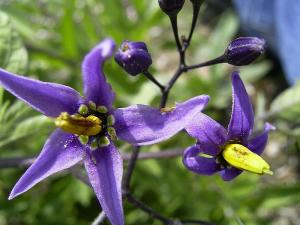European Bittersweet Is Poisonous To Pets

Solanum dulcamara, also known as Bittersweet nightshade, woody nightshade or European bittersweet, is a perennial vine or scrambling shrub with slender stems in the Nightshade Family. Even though all parts of the European Bittersweet are toxic with the highest toxicity being found in the berries, it is also non palatable as the plant has a strong, unpleasant odor which most animals will avoid it. Although pet and livestock losses have been reported, they are rare and very few animals will consume enough to cause a potentially lethal poisoning situation. The pets at highest risk are those that tend to be curious or bore easily and will either chew or ingest the plant for the sake of curiosity or out of pure boredom. When ingested problems of the gastrointestinal tract (vomiting, abdominal pain, inappetence, and diarrhea which may become bloody) and the central nervous system (depression, loss of coordination, weakness, paralysis of the rear legs, collapse, difficulty breathing, convulsions and death) may be noted. The entire plant contains solanine, the same toxin found in green potatoes and other members of the nightshade family. Solanum dulcamara also contains a glycoside called dulcamarine, which is similar in structure and effect to atropine, one of the more serious toxins found in deadly nightshade (Atropa belladonna or Atropa bella-donna). The toxin amount varies with soil, light, climate and growth stage. Ripe fruits are generally less toxic than the leaves and unripe berries, but even ripe berries can be poisonous.
Depending upon the amount of the plant ingested the prognosis will vary from good to poor. There is no specific antidote available and treatment is mainly symptomatic and supportive with the emphasis being on respiratory support as death is almost always due to acute respiratory failure. In cases of a witnessed ingestion, where only a small amount of the plant may have been consumed; vomiting should be induced. Activated charcoal is also a valuable tool at neutralizing the ingested toxins in the stomach. The pet should be watched closely for worsening signs of neurological distress and treated accordingly. In many cases of a minor ingestion, the pet will make a full recovery in a matter of hours. Due to the severe gastrointestinal upset that is common with the ingestion of Black Nightshade, fluid and electrolyte replacement may be necessary. If the pet consumed a large amount and is suffering respiratory or cardiovascular distress it may be necessary to intubate the patient and provide oxygen; vasopressors may also be necessary. Diazepam can be used for the control of convulsions. Prevent further ingestion of the plant and contact your veterinarian.




